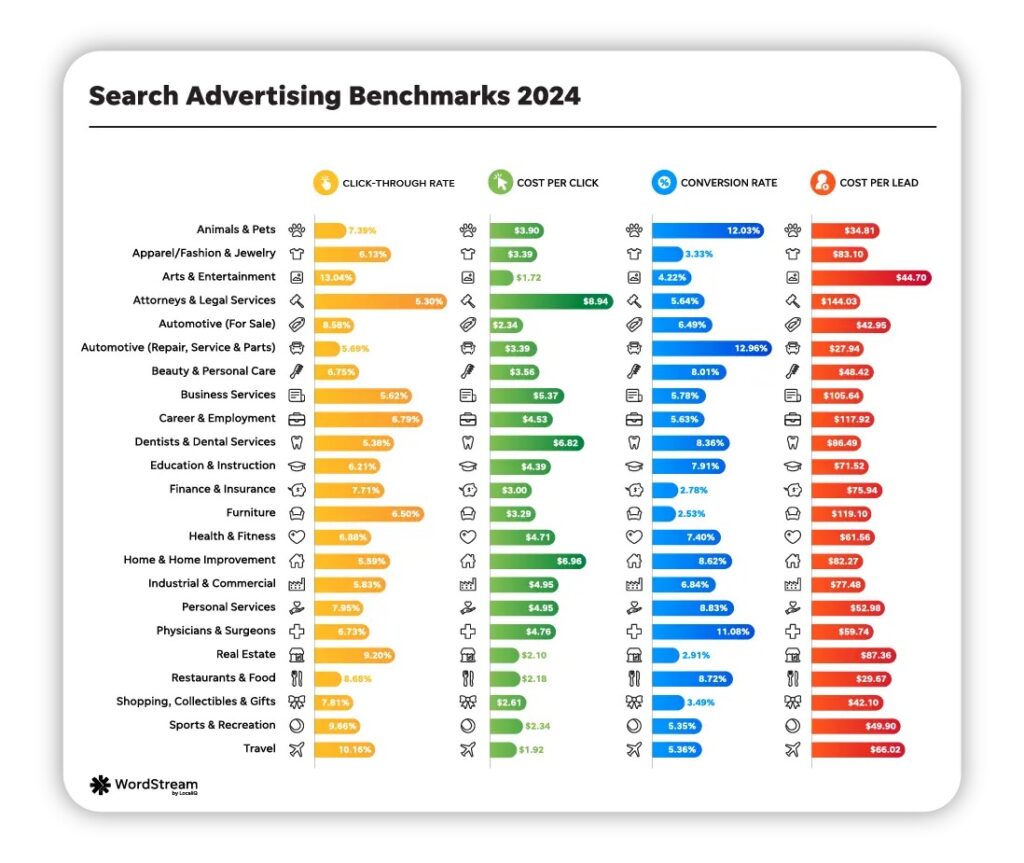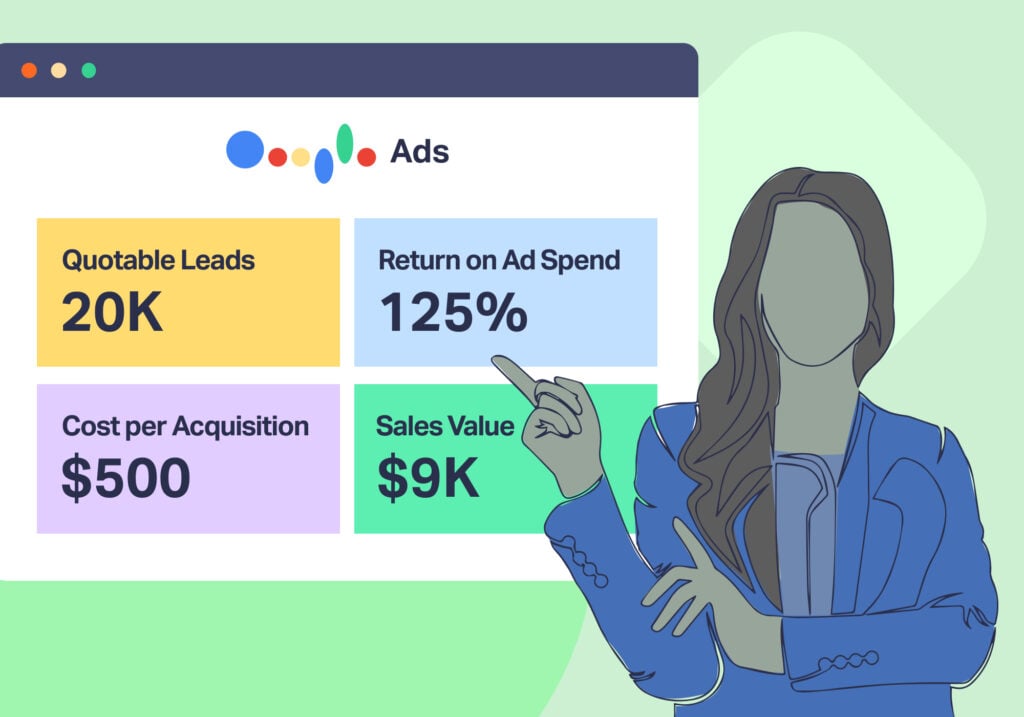
If you’re looking to get more than just pretty numbers from your PPC campaigns, you need to focus on tracking the right ad metrics. Below, we’ll explore the ad metrics that matter for your bottom line—and how to optimize every stage of the funnel to maximize ROI.
What Are Ad Metrics?
“Ad metrics” are quantifiable indicators that reveal how well your campaigns are performing. From impressions and clicks to sales and long-term customer value, these metrics help you make data-driven decisions that translate into tangible business outcomes.
While certain “vanity metrics” (like impressions alone) may look great at first glance, they don’t always connect to real profit. That’s why it’s important to understand which ad metrics deserve your attention—and which ones you can leave behind.
Many times, it’s best to use an ad platform’s native reporting (which is great for engagement metrics)… 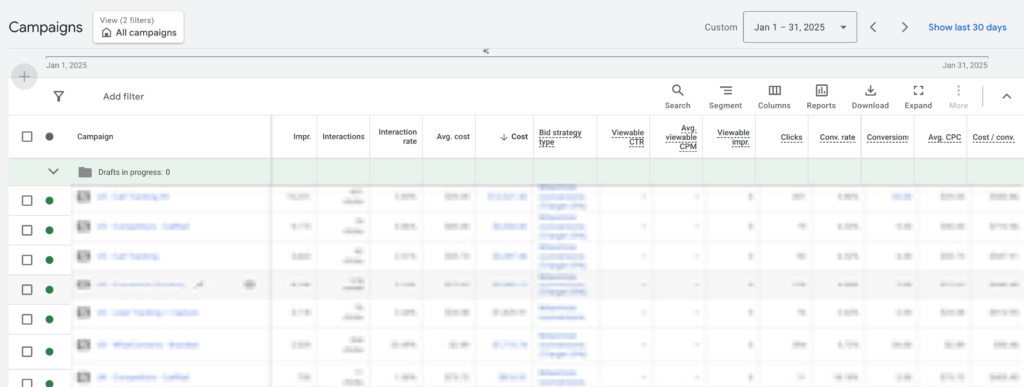
Alongside lead tracking tools like WhatConverts (best for more in-depth lead details). 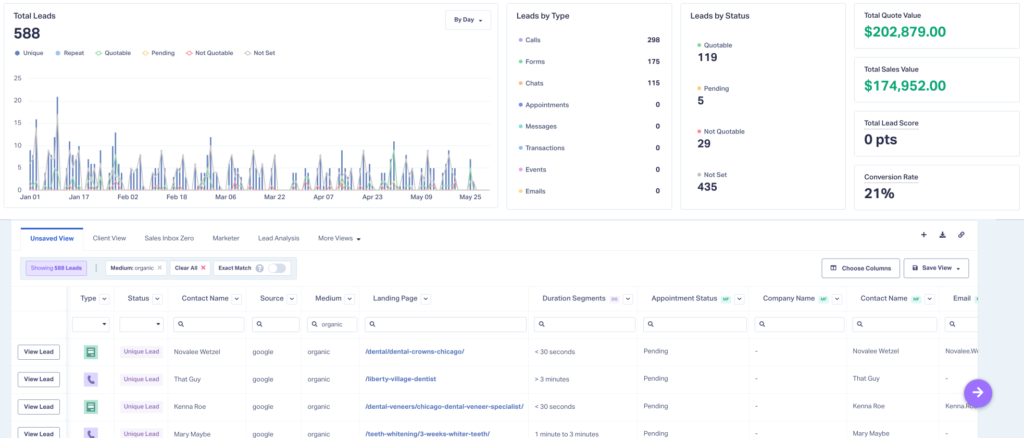
That way you get the full picture of how your marketing is performing, both with engagement metrics (clicks, CTR) and with business-driving metrics (leads, sales value).
Why Ad Metrics Matter
Ad metrics give you the power to:
- Pinpoint what’s working: Identify which ads, keywords, and channels drive the most engagement or revenue.
- Optimize campaigns: Spend more on the elements that deliver results and refine or eliminate underperformers.
- Align marketing and sales: When you track the right metrics, you can tie marketing efforts directly to revenue, improving collaboration across teams.
- Maximize ROI: The sooner you measure true performance based on ad metrics that matter, the easier it is to reduce wasted ad spend.
Pro Tip: Always align ad metrics with larger business goals. If your primary goal is revenue, focus on metrics like Return on Ad Spend (ROAS) and Sales Value over Impressions and Clicks alone.
Benchmarking Metrics
Benchmarking helps PPC professionals understand how their campaigns compare to industry standards. Metrics like Click-Through Rate (CTR), Cost Per Click (CPC), and Conversion Rate vary across industries. For instance, a 2% CTR might be excellent for the legal industry but average for e-commerce.
Use tools like Wordstream’s benchmarks to set realistic performance goals and identify underperforming areas.
Top-Funnel Ad Metrics
Top-funnel ad metrics gauge visibility and engagement. They’re especially useful in the early stages of campaigns or when revenue data isn’t available.
In most cases, you can find top-funnel ad metrics within the ad platform’s native reporting. For example, below you can see various top-funnel metrics in Google Ads: 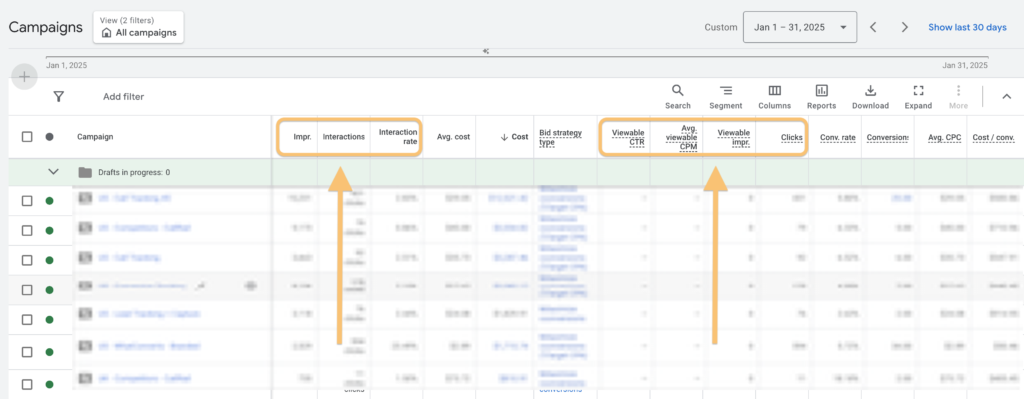
Common Metrics
| Metric | Definition | When to Use | Tools to Use |
| Impressions | The number of times your ad is displayed. | Early-stage campaigns focused on brand awareness. | Ad Platform |
| Clicks | Times users click on your ad. | Measuring engagement after ad exposure. | Ad Platform |
| Click-Through Rate | % of impressions that result in clicks. | Assessing ad relevance and creative performance. | Ad Platform |
| Cost Per Click | Average cost per ad click. | Optimizing budget efficiency in paid campaigns. | Ad Platform |
| Cost Per Mille | Cost to reach 1,000 impressions. | Comparing cost efficiency in display campaigns. | Ad Platform |
Pros & Cons
- Pros: Easy to track, quick feedback on engagement.
- Cons: Often considered vanity metrics; they don’t directly link to revenue.
Common Pitfall: Misinterpreting CTR in Isolation:
A high CTR can be deceptive if few of those clicks lead to conversions. For instance, let’s say Ad #1 has a CTR of 15% (which is amazing!). But how many sales resulted from those clicks? It could be your ad is attracting hordes of non-ideal customers who end up clicking off the page immediately. So, be sure to always pair CTR with at least one mid- or bottom-funnel metric.
Optimization Tips
- Landing Page Alignment: If CTR is high but conversions are low, adjust your landing page to match the ad’s message. The smoother your user journey from one piece of marketing to the next, the more likely prospects will be to convert.
- Ad Copy Testing: Run A/B tests with different headlines and value propositions. More clicks will determine the winner until you have mid or bottom-funnel metrics. Then, switch over to them to determine which copy brings in the most value (remember—clicks don’t always equal value).
- Audience Refinement: Target smaller, more relevant segments. Higher-quality traffic from your target market means better overall engagement—and eventually, more conversions.
Mid-Funnel Ad Metrics
Once potential customers click through and start to convert, it’s time to track leads and lead quality to see how well your campaigns are nurturing interest.
Mid-funnel ad metrics are harder to get to using only an ad platform’s reporting. In many cases, you’ll need to set up conversion tracking to get them, and that can be difficult for users with little development experience. Google Tag Manager (GTM) is the most popular method.
Resource: (Guide from Google) Set Up Conversion Tracking for Your Website
That said, lead tracking tools like WhatConverts can track mid-funnel ad metrics as well and are often easier to set up. Plus, with the right tool, you can see lead quality data that unlocks the Total Quotable (Qualified) Leads and Service/Product Interest ad metrics. Here’s what that looks like in WhatConverts. 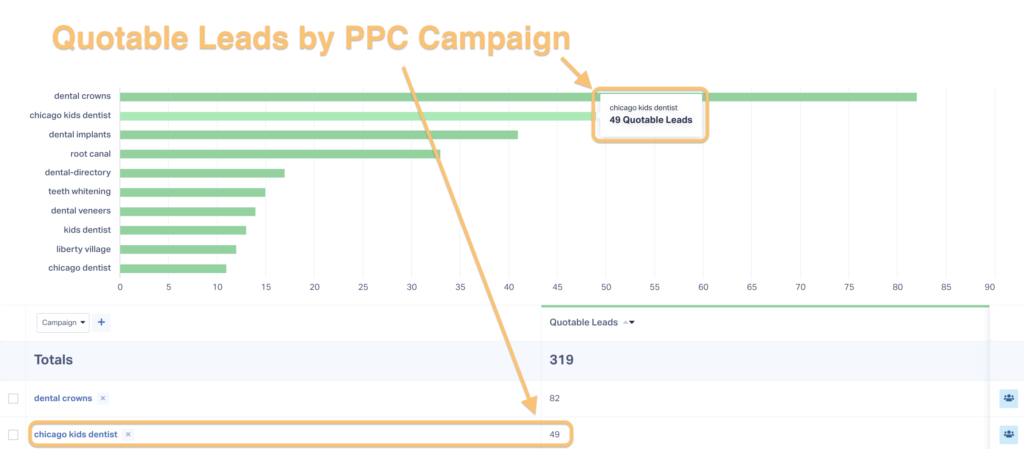
This data lets you see which of your marketing is generating the most valuable leads (not just engagement metrics).
Common Metrics
| Metric | Definition | When to Use | Tools to Use |
| Total Leads | Number of potential customers. | Tracking lead generation performance. | Ad Platform + Tag Manager, WhatConverts |
| Lead Types | Differentiates between calls, forms, etc. | Identifying which channels produce which types of leads. | Ad Platform + Tag Manager, WhatConverts |
| Cost Per Lead | Average cost to generate a new lead. | Evaluating the cost-efficiency of campaigns. | Ad Platform + Tag Manager, WhatConverts |
| Total Qualified Leads | Differentiates between leads and leads likely to become customers (qualified). | Optimizing campaigns based on qualified leads, not just all leads. | WhatConverts |
| Service/Product Interest | Splits leads into service/product categories based on what they’re interested in. | Determining which campaigns generate leads interested in a certain service/product. | WhatConverts |
Pros & Cons
- Pros: Highlights genuine interest, helps pinpoint where leads come from.
- Cons: Requires proper lead-tracking setup, and lead management can be difficult without the right tools.
Common Pitfall: Equating All Leads with Equal Value
A lead that arrives ready to buy is different from a casual browser. Treating them equally can lead to wasted follow-ups and inaccurate campaign evaluations. Be sure you’re targeting leads that take meaningful conversion actions (make a call, fill out a form for a quote) rather than surface-level ones (download an e-book, join a newsletter).
Optimization Tips
- Channel Analysis: Check your CPL by channel. Reallocate budget to channels that yield the most leads at the lowest cost. To do so, be sure you have marketing attribution tools like WhatConverts so you can see exactly which channel is producing the best results.
- Lead Scoring: Implement a lead scoring system in your CRM or use tools like WhatConverts. With lead scoring, you can focus your efforts on leads that are most likely to convert, saving you time and resources so you can keep refining your strategy.
- Ad Timing: Review which times of day or days of the week convert best and schedule ads accordingly. This is called “dayparting” and it’s a great way to maximize your results while minimizing your ad spend.
Bottom-Funnel Ad Metrics
Finally, we have bottom-funnel metrics. These metrics tie ad spend to actual revenue and help you see the direct impact on your bottom line.
Here’s why bottom-funnel metrics are so powerful (if you can track them). Say you have two campaigns: A and B. Campaign A brings 100 clicks while Campaign B brings in just 15. If you’re judging performance on that alone, you’d be tempted to put more budget into Campaign A.
But if you add the extra layer of Sales Value to the equation, you may find Campaign A brought in $500, while Campaign B brought in $5,000. Now where should you be reallocating your budget?
As you can see, having this extra layer of data can drastically strengthen your optimization decisions. That’s why if you can, you should always steer your marketing based on bottom-funnel ad metrics. These are the ones that truly matter for most business goals.
Resource: How to Optimize Your Marketing with Lead Qualification
Common Metrics
| Metric | Definition | When to Use | Tools to Use |
| Customer Acquisition Cost (CAC) | Cost to acquire a customer. | Evaluating efficiency in turning leads into paying customers. | Ad Platform + Tag Manager, WhatConverts |
| Total Quote Value | Revenue potential tied to quotes. | Analyzing projected revenue from leads to forecast future earnings. | WhatConverts |
| Quote Value ROI/ROAS | Return on investment or ad spend based on quote value. | Determining profitability of quotes to optimize budget allocation. | WhatConverts |
| Total Sales Value | Closed sales attributed to campaigns. | Measuring revenue impact of campaigns to assess profitability. | Ad Platform + Tag Manager, WhatConverts |
| Sales Value ROI/ROAS | Return on investment or ad spend from closed sales. | Assessing effectiveness of campaigns in generating profitable sales. | Ad Platform + Tag Manager, WhatConverts |
Pros & Cons
- Pros: Clearly shows how ads contribute to revenue; essential for ROI calculations.
- Cons: Requires full sales-funnel visibility, which can be more complex to track without the right tools.
Common Pitfalls: Relying to Heavily on CAC
Low CAC campaigns might underinvest in high-value customers. For example, a low CAC campaign may generate cheap leads that do end up becoming customers. However, that doesn’t mean these are the most valuable customers. That’s why it’s important to incorporate customer lifetime value (CLV) into your Sales Value ROI. This is a more accurate measure of what marketing is most impactful so you can optimize accordingly.
Optimization Tips
- Budget Reallocation: Double down on campaigns with higher sales value ROI and weed out those where it’s lower. This gives the clearest picture of your strongest marketing. You can see total sales value in WhatConverts by clicking Reports → Report Library → Sales Value by Source/Keyword/Campaign. Or you can generate a Quick Report right from the Lead Manager:
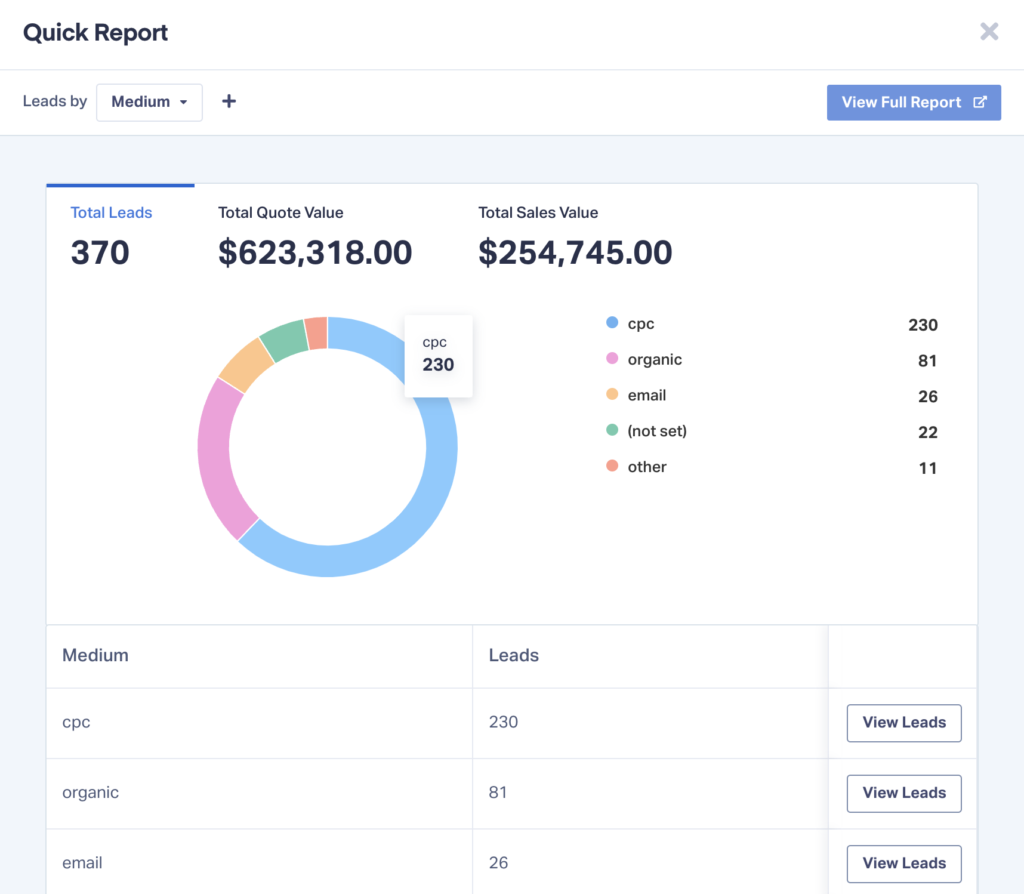
- Follow-Up Strategies: Schedule automated or manual follow-ups to nurture quotes into actual sales. Combine your nurturing techniques with lead scoring to give your sales team the data they need to know who to reach out to first.
- Retention Campaigns: Retarget existing customers with complementary products or services. It’s typically cheaper to re-engage a past customer than acquire a brand-new one.
Key Takeaways & Next Steps
- Focus on the Metrics That Matter
- Impressions and clicks are useful early indicators, but lead and revenue metrics tell the bigger story.
- Align Ad Metrics with Business Goals
- If you’re focused on revenue growth, prioritize sales metrics like Sales Value, ROAS, and CAC.
- Don’t Treat All Leads Equally
- Implement lead scoring or advanced tracking with tools like WhatConverts to see which leads have the highest potential.
- Use Advanced Metrics for Detailed Insights
- ROAS, LTV, and churn rate can highlight where to allocate budget and resources for the greatest long-term ROI.
- Optimize Attribution
- Consider multi-touch attribution to understand how each ad interaction contributes to the final sale.
FAQs
What are ad metrics?
Ad metrics are data points that measure the effectiveness of advertising campaigns.
Which ad metrics matter most for PPC?
Key metrics include ROAS, CTR, CPC, Sales Value, and CAC.
How do I track ad metrics effectively?
Use tools like Google Ads, WhatConverts, and analytics platforms for comprehensive tracking.
Wrapping Up
By choosing the right ad metrics at each stage of the funnel—and avoiding vanity metrics—you’ll gain the clarity you need to optimize campaigns, justify your ad budget, and fuel long-term growth.
Ready to maximize your PPC ROI? Start your free 14-day trial of WhatConverts today!
Get a FREE presentation of WhatConverts
One of our marketing experts will give you a full presentation of how WhatConverts can help you grow your business.
Schedule a Demo
Grow your business with WhatConverts






